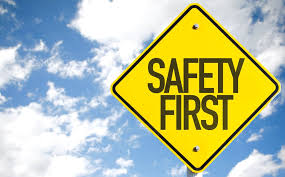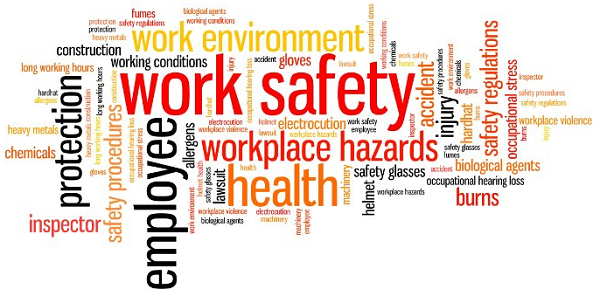The origins of the concept of Workplace Safety can be traced back to the labour movement during the Industrial Revolution in Europe in the 18th century. During this revolution, workers’ unions were formed to work for the benefit of workers. The workers began to demand better working conditions. The authorities gradually joined the demands of the workers and adopted a number of regulatory measures in this regard.
What is workplace safety?
Workplace safety is a complex area related to the safety, health and well-being of people at work. It outlines strategies and practices for ensuring the health and safety of workers in the workplace.
Workplace safety includes the awareness of employees related to knowledge of the basics of safety, the hazards in the workplace, the risks associated with hazards, the implementation of measures to prevent hazards, and the practice of the required safer practices, techniques, processes and safety culture in the workplace.
It also includes safety rules and regulations that are largely based on existing government policies. Each organization sets out a number of safety rules for its employees. Occupational safety training and education are periodically conducted to keep them familiar with the latest safety measures and to update them.
Workplace safety is about putting an end to injuries and illnesses in the workplace. Therefore, it is about protecting the assets, health and life of employees. It also reduces the cost of lost work time, time spent on short-term care, and scheduling and services that can drop due to fewer service providers, pressure on those providers who select the part of the absent staff, or a bad case where you have to close or close the program due to the lack of suppliers.
The need for safety in the workplace
Before analyzing the various aspects of safety in the workplace, it is pertinent to know the reasons for safety in life. We prioritize safety in the places where we live, stay, visit or work.
- Say “No” to accidents. Accidents are the consequences of recklessness and lack of responsibility. When we fail to comply with the required safety standards, we will end up injuring ourselves or even ending our valuable lives. This is true both in our home and in the workplace.
- To stay healthy and energetic – we must have a healthy eating habit, which is in itself a safety measure to keep us healthy and alive for work at home and in the workplace.
- To have longevity in life, we must take care of ourselves, wherever we are, and of others, in order to lead a safe and meaningful life.
- Creating public awareness – promoting safety standards everywhere creates public awareness and discipline. This applies to the workplace and encourages new employees to take the safety measures necessary to keep them safe.
- To avoid loss of property and lives. The main purpose of safety measures is to prevent accidents and hazards that sometimes lead to serious loss of life and property.
- Develop planning for security – The need for security paves the way for developing effective planning for the overall safety of people in an organization.
Say “No” to accidents. Accidents are the consequences of recklessness and lack of responsibility. When we fail to comply with the required safety standards, we will end up injuring ourselves or even ending our valuable lives. This is true both in our home and in the workplace.
To stay healthy and energetic – we must have a healthy eating habit, which is in itself a safety measure to keep us healthy and alive for work at home and in the workplace.
To have longevity in life, we must take care of ourselves, wherever we are, and of others, in order to lead a safe and meaningful life.
Creating public awareness – promoting safety standards everywhere creates public awareness and discipline. This applies to the workplace and encourages new employees to take the safety measures necessary to keep them safe.
To avoid loss of property and lives. The main purpose of safety measures is to prevent accidents and hazards that sometimes lead to serious loss of life and property.
Develop planning for security – The need for security paves the way for developing effective planning for the overall safety of people in an organization.
The main goals of safety in the workplace
The main goals of safety in the workplace:
- Preserving and promoting the health and well-being of workers or workers
- Improving employee performance by providing a safe and supportive work environment
- Growing an organization that remains free of potential dangers and setbacks
- Promoting a supportive social climate in the organization that motivates employees to work effectively to achieve organizational progress and prosperity
- Ensure the health and safety of workers and workplaces by eliminating or minimizing risks
- Achieve higher employee productivity by providing a safe and secure environment
- Focus on the safety and health of workers associated with chemicals and hazardous elements used in the workplace.
Preserving and promoting the health and well-being of workers or workers
Improving employee performance by providing a safe and supportive work environment
Growing an organization that remains free of potential dangers and setbacks
Promoting a supportive social climate in the organization that motivates employees to work effectively to achieve organizational progress and prosperity
Ensure the health and safety of workers and workplaces by eliminating or minimizing risks
Achieve higher employee productivity by providing a safe and secure environment
Focus on the safety and health of workers associated with chemicals and hazardous elements used in the workplace.
Workplace Safety – Importance
Maximum employees spend at least eight hours a day at the workplace. Therefore, the domain in the workplace must be safe and healthy. Every day employees across the universe experience a variety of health problems arising from various sources such as –
- Dust
- gases
- Noise
- Vibrations
- Excessive temperatures
Safety and health in the workplace surround the social, mental and physical well-being of workers in all professions. Imperfect and unhygienic work situations can compromise the health and safety of the worker. Harmful and hazardous working conditions can be found anywhere, be it a workplace in a building, a home, or another country.
Unfortunately, some employers lack the common sense to prevent risks and threats to workers’ health and safety. In fact, some employers are not even aware that they are legally responsible for protecting workers from work-related hazards and risks.
[mks_highlight color=”#ff0a0a”][/mks_highlight]As a result of this problem and a lack of knowledge and focus on health and safety, work-related accidents are common in all parts of the world.
Work-related hazards and illnesses are common in almost all parts of the world and often have many personal and secondary negative outcomes for workers and their families. Individual hazards and illnesses can mean significant financial losses for both employees and employers.
Successful health and safety programmers can help protect the lives of employees by reducing risks and outcomes. Productive programmers can also have a constructive impact on both employee confidence and productivity and can save employers a lot of money. In fulfilling this promise, the security measures are as follows.

- Develop and implement successful policies, strategies and programs that ensure a safe and healthy workplace and that promote the health and safety and well-being of their staff, as well as their clients and the public.
- Authorization for daily use of professional health and safety policies, programs and strategies.
- Take all precautions to ensure that their work does not cause harm to employees, customers or the general public, hazards, injury, illness, or environmental problems.
- Observe and comply with all laws and regulations regarding health, safety and the environment.
- Educate recruits on their health, safety and environmental responsibilities and work-related accidents and hazards and on safety drills in their workplace.
Develop and implement successful policies, strategies and programs that ensure a safe and healthy workplace and that promote the health and safety and well-being of their staff, as well as their clients and the public.
Authorization for daily use of professional health and safety policies, programs and strategies.
Take all precautions to ensure that their work does not cause harm to employees, customers or the general public, hazards, injury, illness, or environmental problems.
Observe and comply with all laws and regulations regarding health, safety and the environment.
Educate recruits on their health, safety and environmental responsibilities and work-related accidents and hazards and on safety drills in their workplace.
The areas of safety provisions for the health, safety and environmental safety measures of paramount importance and recognize the rights of every employee to work in a safe and healthy workplace.


 Home
Home









